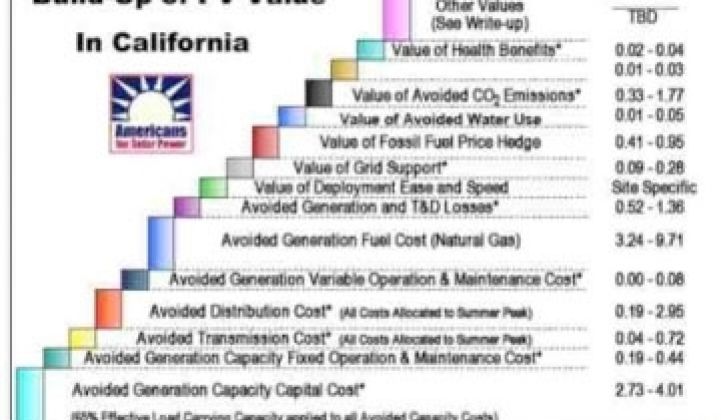The feed-in tariff (FIT) has exploded renewable growth every place it has been implemented and a new study from UC Berkeley says it will do the same in California. But handling explosive growth is not easy. The people responsible for keeping the state's lights and air conditioning on are scrambling -- and not always wholeheartedly -- to understand and prepare for the FIT.
A FIT is an above-retail rate ("tariff") paid for renewable energy-generated electricity that producers "feed" into the grid. It was first used in California in the late 1970s and early 1980s but failed at that time due to design flaws and lack of support. Revived in Germany with stunning success in the early 2000s, the FIT concept has subsequently been used successfully, according to Professor Dan Kammen, the lead author of the UC Berkeley study and one of the foremost U.S. renewable energy authorities, in at least fifteen countries. Dozens more are considering implementation.
The proposed California FIT has been carefully designed to drive the growth of projects in the one-to-twenty-megawatt range. This spectrum encompasses both small solar systems driven by the state's "million solar roofs" initiative and utility-scale projects driven by its Renewable Electricity Standard (RES) that requires regulated utilities to obtain twenty percent of their power from renewable sources by the end of this year and 33 percent from renewable sources by 2020.
At Southern California Edison (SCE), one the state's most visible utilities, Mike Marelli, the Director of Contracts for Renewables, does not object to the idea of a well-designed FIT, but is not sure it is the best way to get to the state's renewables goals, though Sacramento's proposed Renewable Energy and Economic Stimulus Act (REESA) would institute such an initiative.
"We procure across the whole spectrum of different renewables," Marelli said. "Feed-in tariffs are one area of that spectrum." He described SCE's Renewable Standard Contract and Rooftop PV programs, both of which have advanced the utility's portfolio of renewable resources. SCE has contracts for "way beyond the 20 percent goal, " Marelli said.
According to the study Economic Benefits of a Comprehensive Feed-In Tariff: An Analysis of the REESA in California, from Kammen and Max Wei of the University of California, Berkeley's Renewable and Appropriate Energy Laboratory Energy and Resources Group, a well-designed feed-in tariff like the one used by the newest version of REESA, will bring California $2 billion in additional tax revenues and $50 billion in new investment, add an average of 50,000 new jobs each year for a decade and provide the mega-growth in renewables that California will need to meet its newly mandated standard of 33% renewable electricity by 2020.
"Feed-in tariffs can work," SCE's Marelli acknowledged, "but they require a lot of work to make sure they remain current with what is going on in the market."
Marelli described two important shortcomings of a typical FIT program. "The fundamental issues in the renewables business and advancing these projects," Marelli said, "are around access to transmission and project site permitting. The feed-in tariff itself doesn't really address those two key hurdles."
"Those are two valid points," Professor Kammen said of Marelli's concerns. "He's right. The feed-in tariff doesn't address interconnection." But, Kammen pointed out, "one bill doesn't need to do everything."
Craig Lewis is Executive Director of the FiT Coalition that designed the REESA feed-in tariff. He believes the one-to-twenty-megawatt wholesale distributed generation (WDG) projects targeted by the measure will make permitting and interconnection to the grid much easier. "The relatively small size of WDG projects and their location within the distribution grid means these projects can be built immediately. WDG projects can be financed and permitted with relative ease on rooftops and disturbed lands, without dependence on new transmission lines," Lewis wrote in a recent advocacy piece. "WDG is a better deal for ratepayers than the large central station projects that require transmission build-outs and suffer the inefficiencies of transporting energy over long distances."
Marelli didn't see the advantages of the FIT in quite the same way and said others in the energy business see the same challenges with permitting and transmission. "This has been recognized by the California Independent System Operator (CAISO) and there is an initiative underway to reform the interconnection process for small generators, those that are less than twenty megawatts. It is by no means a slam dunk."
Gregg Fishman, a spokesman for the ISO, said it is true they have been working on interconnection. "The energy industry is seeing the most significant changes, potentially in its history, from the need to integrate renewable resources. The industry grew up around large central station generators," Fishman said. "Now, with the need to integrate more renewable resources, the industry is having to adapt. Certainly the ISO is in the process of adapting its policies and its procedures. Every utility is also somewhere in that process."
"The market is different and evolving," Kammen said, "but I think that the real issue here is that it looks different. That's just something that has to be learned about. If anything, this provides more cost effective opportunities for the utilities," he pointed out. "I see this as a positive step for them."
"It's just a matter of going through the process and figuring out what works and applying those lessons," according to the ISO's Fishman. "I think there's good reason to believe that the energy industry can adapt to the changes that are occurring because there are signs that everybody is doing it. It's not a slam dunk but there's no reason it can't work."



